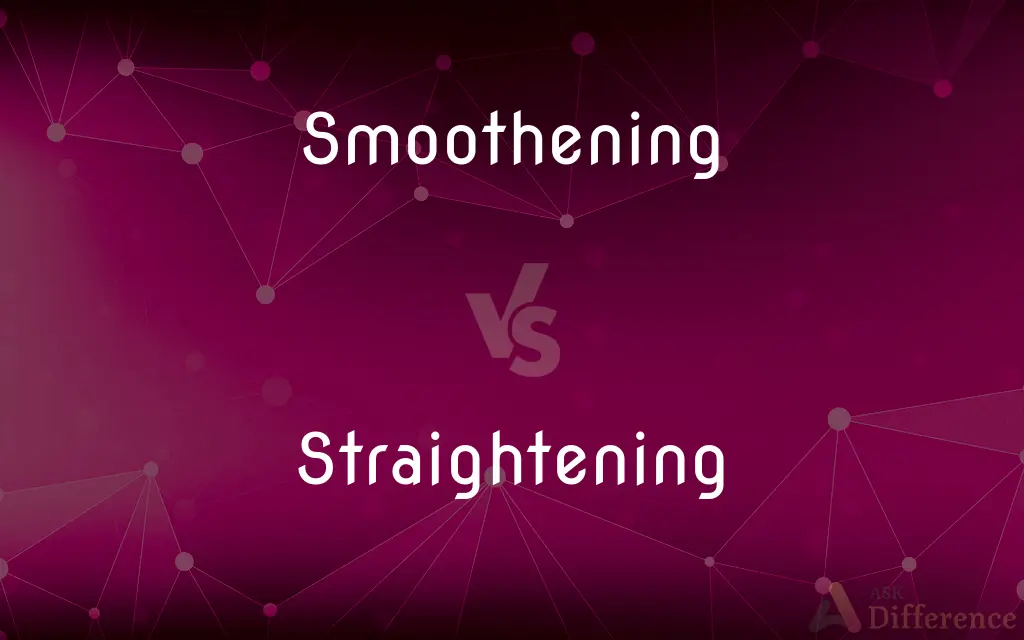Smoothening vs. Straightening — What's the Difference?
By Tayyaba Rehman — Published on January 23, 2024
Smoothening is a hair treatment process aimed at reducing frizz and adding softness and shine, while maintaining some natural texture. Straightening is a hair styling technique that involves flattening and straightening hair to achieve smooth appearance.

Difference Between Smoothening and Straightening
Table of Contents
ADVERTISEMENT
Key Differences
Hair smoothening is a chemical process designed to soften and smoothen hair texture, making hair look sleek and manageable without altering its natural structure significantly. Hair straightening, on the other hand, involves physically altering the hair's structure to achieve straight hair, often using heat or chemical treatments.
Smoothening treatments typically use a milder formula compared to straightening treatments, aiming to reduce frizz and add silkiness to the hair. Straightening treatments, such as rebonding, provide a more permanent solution to curly or wavy hair, offering a pin-straight look.
The effects of smoothening are often seen as more natural-looking, as they soften curls rather than completely eliminating them. Straightening, particularly chemical straightening, can dramatically change hair's texture and appearance, offering a sleek, straight style.
Smoothening treatments generally last for a few months and are less damaging to the hair compared to straightening treatments. Straightening treatments, especially when involving chemicals or excessive heat, can lead to more hair damage if not properly maintained.
Maintenance for smoothened hair usually involves using specific shampoos and conditioners to prolong the effect, whereas straightened hair may require more intensive care and frequent touch-ups, especially at the roots as hair grows.
ADVERTISEMENT
Comparison Chart
Purpose
Reduces frizz, adds softness and shine
Achieves flat, straight hair
Formula
Milder chemical treatment
Often involves stronger chemicals or heat
Natural Appearance
Maintains some natural texture
Offers a pin-straight, sleek look
Hair Damage
Generally less damaging
Can be more damaging
Maintenance
Requires specific hair care products
May require intensive care, frequent touch-ups
Compare with Definitions
Smoothening
Provides a natural, silky appearance.
Smoothening gave her hair a natural shine and silkiness.
Straightening
Flattens and straightens hair.
Hair straightening transformed her wavy hair into sleek, straight locks.
Smoothening
Reduces hair frizz and enhances softness.
After smoothening, her hair became softer and more manageable.
Straightening
Often involves heat or chemical treatments.
She used a flat iron for straightening her hair at home.
Smoothening
Uses chemicals to soften hair texture.
She opted for hair smoothening to tame her curly locks.
Straightening
Provides a pin-straight hair look.
Chemical straightening gave her the pin-straight hair she always wanted.
Smoothening
Less damaging compared to straightening.
She chose smoothening as it was gentler on her hair.
Straightening
Can lead to hair damage if not maintained properly.
Regular straightening without proper care resulted in hair damage.
Smoothening
Requires specific maintenance.
Post-smoothening, she used sulfate-free products for maintenance.
Straightening
Requires intensive care and frequent touch-ups.
She schedules regular salon visits for touch-ups after straightening her hair.
Smoothening
To make or become smooth.
Straightening
To make or become straight or straighter.
Smoothening
Present participle of smoothen
Straightening
The act of making something straight.
Common Curiosities
Is smoothening less damaging than straightening?
Generally, yes. Smoothening is considered milder and less damaging.
Can straightened hair become curly again?
Over time or without proper care, straightened hair can revert to its natural state.
What is hair smoothening?
It's a treatment to reduce frizz and enhance hair softness, maintaining some natural texture.
How long does smoothening last?
Hair smoothening typically lasts a few months, depending on hair care and maintenance.
Can I smoothen my hair at home?
Professional smoothening is recommended for the best and safest results.
Will straightening make my hair permanently straight?
Chemical straightening can last longer, but no treatment permanently alters hair texture.
Does hair straightening require touch-ups?
Yes, especially at the roots as hair grows.
What does hair straightening do?
Straightening flattens and straightens hair for a sleek, smooth appearance.
Is straightening suitable for all hair types?
Straightening can be done on most hair types, but it's essential to consider hair health and texture.
How often should I straighten my hair?
Limit the frequency to minimize damage, and always use heat protection products.
Can I color my hair after straightening or smoothening?
Wait for a few weeks after the treatment to color your hair to avoid excessive damage.
Do I need special products after hair smoothening?
Yes, using specific shampoos and conditioners designed for smoothened hair is recommended.
Does smoothening work on very curly hair?
It softens curls and reduces frizz but doesn't make curly hair completely straight.
What should I avoid after hair smoothening?
Avoid washing your hair frequently, using harsh chemicals, and excessive heat styling.
Is smoothening better for frizzy hair?
Smoothening is effective for taming frizz while keeping some natural waves.
Share Your Discovery

Previous Comparison
Tunneled Catheter vs. Non-Tunneled Catheter
Next Comparison
Geckos vs. ChameleonsAuthor Spotlight
Written by
Tayyaba RehmanTayyaba Rehman is a distinguished writer, currently serving as a primary contributor to askdifference.com. As a researcher in semantics and etymology, Tayyaba's passion for the complexity of languages and their distinctions has found a perfect home on the platform. Tayyaba delves into the intricacies of language, distinguishing between commonly confused words and phrases, thereby providing clarity for readers worldwide.












































